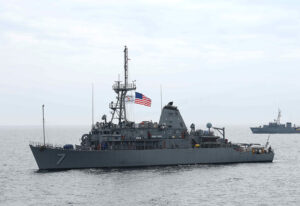When Did the Navy Use Asbestos on Minesweepers?
The Navy used asbestos on all Navy ships built between the 1930s and early 1980s, including minesweepers. As a result, military personnel who served during this time were at high risk of asbestos exposure.
 The decision by asbestos product manufacturers to cover up the dangers of this material caused millions of Navy veterans to develop mesothelioma and other life-altering diseases 10 to 50 years after they were first exposed.
The decision by asbestos product manufacturers to cover up the dangers of this material caused millions of Navy veterans to develop mesothelioma and other life-altering diseases 10 to 50 years after they were first exposed.
Once the Navy realized the risk of exposure to asbestos in the 1980s, asbestos was largely replaced by other materials. However, veterans who came in contact with asbestos-containing products before this time are still at risk of being diagnosed with mesothelioma today.
Key Facts: Asbestos on Minesweepers
- Number of minesweepers affected: Nearly 300
- Products: Pumps, boilers, pipes, gaskets, engines, wiring, and other components
- Related diseases: Mesothelioma, lung cancer, and asbestosis
- Compensation options: Veterans disability payments, asbestos trust fund claims, and mesothelioma lawsuits
If you were exposed to asbestos on minesweepers, you may be able to access disability benefits from the U.S. Department of Veterans Affairs (VA) and other forms of financial compensation.
Our team of VA-accredited attorneys can file claims on your behalf if you qualify. Download our Free Veterans Compensation Guide now to learn more about your options.
List of U.S. Navy Minesweepers That Used Asbestos
Nearly 300 U.S. Navy minesweepers built between the 1930s and the early 1980s used asbestos. Navy veterans and shipyard workers who served on minesweepers at any point in this time frame were probably exposed to asbestos.
Asbestos could be found on these minesweepers:
- USS Avenge (AM-423)
- USS Candid (AM-154)
- USS Conflict (AM-85)
- USS Defense (AM-317)
- USS Devastator (AM-318)
- USS Direct (AM-430)
- USS Energy (AM-43)
- USS Excel (AM-439)
- USS Indicative (AM-250)
- USS Jubilant (AM-255)
- USS Kingfisher (AM-25)
- USS Knave (AM-256)
- USS Lapwing (AM-1)
- USS Logic (AM-258)
- USS Lucid (AM-259)
- USS Peregrine (AM-373)
- USS Strength (AM-309)
- USS Surfbird (AM-383)
- USS Tanager (AM-5)
- USS Triumph (AM-323)
- USS Valor (AM-472)
- USS Velocity (AM-128)
- USS Waxwing (AM-389)
- USS Widgeon (AM-22)
- USS Zeal (AM-131)
This isn’t the complete list of minesweepers that contained asbestos. Use our free search tool below to see if a ship you served on had asbestos and learn what you can do next.
- Type of Ship:
- Asbestos Used: Yes
Learn more about asbestos on Navy ships in our Free Veterans Guide.
Get Your Free GuideWhy Did the U.S. Navy Use Asbestos in Minesweepers?
Minesweepers were designed to counter the threat of explosive underwater mines planted by enemy ships. During World War II, they played a critical role in clearing dangerous mines from the sea and shore to ensure safe passage for other naval vessels.
The Navy used asbestos on minesweepers because it could:
- Cover steam pipes in the form of felts, packing material, gaskets, and pads
- Insulate high-temperature areas such as boiler rooms
- Reduce costs, since asbestos was inexpensive
- Soundproof Navy vessels for military accuracy
- Withstand salt water and high temperatures
Once asbestos is breathed in or swallowed, it can irritate the protective lining of major organs and cause scar tissue to form. Over time, cancerous growths may develop in the scar tissue and lead to mesothelioma, lung cancer, and other illnesses.
Navy veterans exposed to asbestos on minesweepers or other ships may also develop non-cancerous diseases like pleural plaques and asbestosis.
Who Was Exposed to Asbestos on Minesweepers?
Anyone who spent time on minesweepers may have been exposed to asbestos. This includes shipyard workers and Navy sailors who served on these vessels.
Workers who built and kept minesweepers running may have had the greatest amount of asbestos exposure.
At-risk Navy personnel included:
- Boilermakers
- Electricians
- Engine room workers
- Insulators
- Machinists
- Pipefitters
- Plumbers
- Shipbuilding workers
- Welders
Our Patient Advocates can see if you qualify for veterans benefits and payouts from the asbestos companies that may have caused your illness. Take the first step now by downloading our Free Veterans Compensation Guide.
Where Was Asbestos Used in Minesweepers?
Asbestos was widely used in products found throughout minesweepers, including:
- Boilers, where water was boiled to produce steam used to power the vessels
- Engines, which were used to move the vessels through the water
- Gaskets, which were usually made with asbestos to hold different components together
- Piping, which transported water through minesweepers for different uses
- Turbines, which turned water from the boilers into steam
- Valves, which directed water flow throughout minesweepers
When any of these components were disturbed, asbestos fibers could become airborne and travel through the ship, where they could be breathed in by anyone onboard.
Compensation for Asbestos on Minesweepers
Navy veterans diagnosed with an asbestos illness after serving on a minesweeper have several ways to seek compensation for their treatment and living expenses.
These options for compensation include:
- VA benefits: Married veterans who’ve been diagnosed with mesothelioma may be eligible for nearly $4,000 a month in tax-free disability payments. A successful VA claim can also provide veterans and their families with free or low-cost medical care, pensions, burial and funeral benefits, and more.
- Asbestos trust funds: Asbestos victims may receive compensation for medical care and other losses by filing asbestos trust fund claims. Asbestos trust funds were created during bankruptcy proceedings by asbestos companies in order to compensate current and future victims. There’s currently over $30 billion already set aside in trust funds.
- Mesothelioma lawsuits: Navy veterans can file personal injury lawsuits against asbestos manufacturers that don’t have trust funds. Most of these legal claims settle out of court with an average of $1.1 to $1.4 million awarded to victims. You can still receive VA benefits if you file a lawsuit.
Settlement Amounts for Veterans Exposed to Asbestos on Minesweepers
Notable mesothelioma settlements secured by our partner law firm include:
- $1.83 million for an Arizona Navy veteran with mesothelioma who did welding work on the USS Nehenta Bay, USS Petrof Bay, USS Kula Gulf, and USS Swanee
- $1.65 million for a Minnesota laborer who served on the USS Augury and later developed mesothelioma
- $1.39 million for a Navy veteran from Oregon with mesothelioma linked to his service on the USS Pine, USS Zeal, USS Redhead, USS Pivot, USS Force, USS Pandemus, and USS Preston
- $1.28 million for an Arizona welder diagnosed with pleural mesothelioma after serving as a Navy welder on the USS Orion, USS Kankakee, USS Fulton, USS Kitty Wake, USS Pelican, USS Sunbird, and USS Bushnell
Get Help If You Were Exposed to Asbestos on Minesweepers
If you served on minesweepers and were potentially exposed to asbestos during your military service, it’s important to seek help as soon as possible. Asbestos exposure can lead to serious health issues, including mesothelioma and other asbestos-related diseases.
Mesothelioma Hope has 20+ years of experience helping veterans and their families after a diagnosis. We can help you apply for benefits — or increase your VA disability rating — and connect you with top attorneys who can file private legal claims on your behalf.
Give us a call at (866) 608-8933 or download your Free Veterans Compensation Guide right now to get started.
Asbestos on Minesweepers FAQs
What are minesweepers made of?
Minesweepers built before the 1980s were made with a variety of different products — and one of the most dangerous was asbestos.
Asbestos-containing materials were used throughout minesweepers to help keep the vessels durable and fireproof.
However, any U.S. Navy veteran exposed to asbestos on minesweepers could develop mesothelioma and other deadly illnesses 10-50 years later.
Which U.S. Navy ships had asbestos?
Nearly all U.S. Navy ships and vessels contained asbestos up until the early 1980s, including minesweepers, battleships, aircraft carriers, auxiliary ships, frigates, and others.
Due to the mineral’s fire-resistant properties, it was commonly used in various ship areas and engine-room components, such as asbestos insulation, gaskets, pipes, valves, and flooring.
Is asbestos still used on ships?
No, the Navy officially stopped using asbestos-containing products to build minesweepers and other ships starting in the 1980s.
However, if you served on a Navy ship before this time frame, you could have been exposed to asbestos and are at risk of being diagnosed with mesothelioma today. This is because it takes 10-50 years for mesothelioma to develop after asbestos exposure.
You should see a mesothelioma doctor as soon as possible if you experience symptoms of an asbestos-related disease (like a cough or difficulty breathing) after serving on a minesweeper decades ago.
Can you file a lawsuit against the Navy for asbestos exposure?
No, you cannot sue the Navy or U.S. government for asbestos exposure. However, you can sue the asbestos manufacturers whose products may have caused your illness.
Talk to a qualified asbestos lawyer to learn more about your options.
Can you get VA benefits for asbestos on minesweepers?
Yes, you may be eligible for nearly $4,000 in monthly disability compensation and other VA benefits if you have a health condition caused by asbestos on minesweepers or another Navy ship.
Call (866) 608-8933 to get answers to your questions and see if you can file a VA claim.



